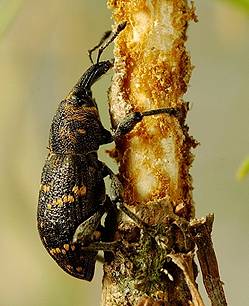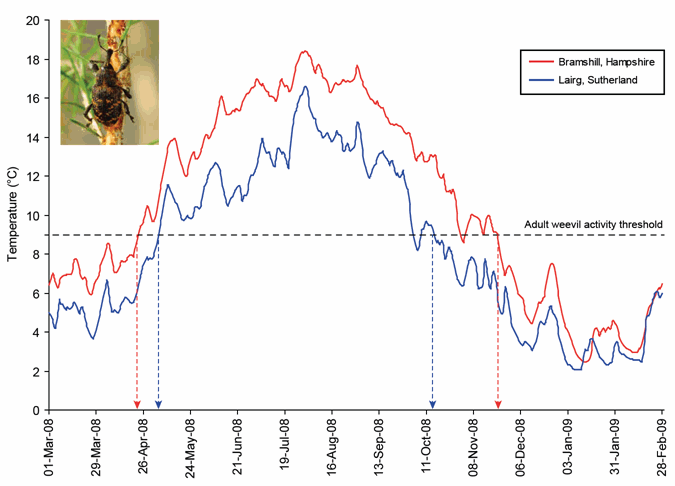Summary
Size matters: An unexpected effect of climate change

Figure 1. An adult pine weevil feeding on a young pine seedling. The stem has been girdled, so killing the tree.
The pine weevil, Hylobius abietis, is a serious and widely distributed pest of European plantation forestry. Larvae develop below ground in the ‘protected’ environment of root-stumps of felled conifers, feeding upon on the inner bark. Adults emerge to feed on the stems of replanted seedlings, and because the adults are large relative to seedling trees, a single individual can damage or kill several young plants.
The biology and life cycle of this important forestry pest are explained more fully here: Pine Weevil biology.
Temperature and weevil development
In the UK, Hylobius most often has a 2-year life cycle, but generation time (voltinism) across its broad Palaearctic range can vary from a single year (univoltine) in the warmer southern forests, up to 4 years in the cooler north. This indicates a flexible life cycle which is responsive to local conditions. Rising temperatures under climate change are likely to affect both the duration of the weevil life cycle, and the seasonal timing of adult activity, which will in turn affect the economic impact of this pest and the way in which it is managed.
To determine the effect of temperature upon weevil growth and development, we carried out laboratory experiments with the different life stages of Hylobius abietis. We found that development rate of the eggs, larvae and pupae increased linearly with temperature, but that the development of prepupal larvae was highly variable, and that this stage has a tendency to undergo a facultative diapause, which was initiated by development temperature (see Box A below).
Therefore, weevils reared at higher temperatures grow faster, but contrary to expectations, are also larger (Figure 2).

Figure 2. The effect of temperature and sex on mean pine weevil mass. Final mass of larvae (top) and adults (below) is illustrated.
Temperature and insect size
Most insect species (over 80%) mature at a smaller size when they develop at higher temperatures – this is known as the Temperature-Size Rule (TSR). Pine weevil in contrast, increases in size with temperature, following an ‘inverse TSR’. Being larger has numerous advantages. Bigger insects are less susceptible to environmental causes of mortality (e.g. they may have more fat reserves reducing overwintering mortality), and larger females tend to be more fecund and lay larger eggs. This in turn increases the chances of offspring survival, since larvae hatching with a greater initial mass develop faster and have lower mortality levels (Figure. 3).

Figure 3. Relationship between initial mass of Hylobius abietis larvae and percent survival at different life stages. Illustrated is survival of the number entering each stage.
Implications of the inverse TSR and climate change
By the 2080s, mean summer temperatures are predicted to rise by around 2.5 °C in Scotland, and 4 °C in southern England. Weevil activity is already longer in southern England by up to 6 weeks, compared to Scotland (Figure. 4), and a warming climate will extend the periods during which weevils can be damaging.
With a flexible life cycle spent largely in a protected environment, Hylobius is likely to benefit from both warmer summers and winters, with continuous larval development possible in some parts of its range. The higher temperatures will also increase development rate and reduce occurrence of prepupal dormancy (see Box A below), expanding the geographical range of univoltine development. Under predicted climate change scenarios, most other insects will mature at a smaller size as the temperature rises. As a consequence of the inverse TSR however, Hylobius will respond to higher temperatures by maturing at a larger size and becoming more fecund. Since large weevils have a higher feeding rate, lower mortality and more offspring, when combined with an extended feeding period and a faster generation time, there is the potential for considerably increased damage by this weevil.

Figure 4. The influence of geographic location on adult weevil activity. Soil temperature at 30 cm depth over one year presented. Dotted arrows indicate the beginning and end of the potential period of damage by the weevil.
Box A: Importance of the prepupal stage in the life cycle

Figure 5. Prepupal Hylobius larva excavating the pupal cell.
Before pupating, Hylobius larvae were found to enter a quiescent ‘prepupal’ stage. The length of time spent as a prepupa is highly variable, with a non-linear relationship between development time and temperature. However, as development temperature decreases, there is a step-like increase in the length of the prepupal stage. The temperature range 20 °C-17.5 °C marked the transition between a median prepupal development time of approximately 25 days and 90 days. The extended prepupal period appears to be a facultative diapause initiated by temperature, and is only averted when larvae develop at temperatures that are relatively high for a north temperate soil environment. Prepupal dormancy may function primarily to minimise the risk of overwintering in the pupal stage, which appears to be more vulnerable to mortality at low temperatures. It may also synchronise the life cycle, regulating the adult emergence in the spring.
Further information & resources
Inward, D.J.G., Wainhouse, D. and Peace, A. (2012). The effect of temperature on development and life cycle regulation of the pine weevil Hylobius abietis, and the potential impacts of climate change. Agricultural and Forest Entomology, (DOI: 10.1111/j.1461-9563.2012.00575.x)
Further reading about Pine weevil, and how it can be managed without the use of chemical controls:
Managing the Pine Weevil on Lowland Pine.
Forestry Commission Practice Note 14.
We have additionally developed an integrated management system to help minimise the impact of Hylobius abietis. Details can be found here: Integrated forest management (IFM) of Hylobius abietis
Alternatively contact:
